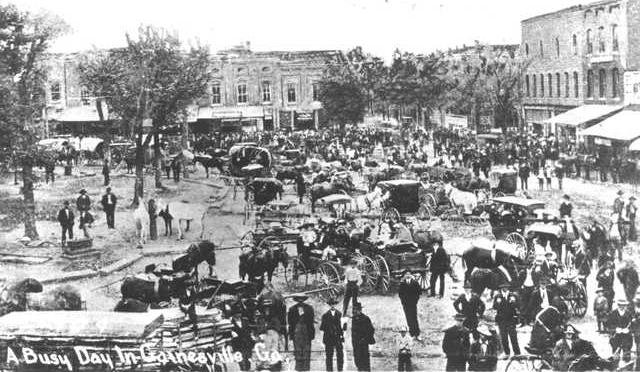Gainesville had no clue, of course, that it would be the bull's eye for a record tornado that would ravage its downtown early on a Monday morning, April 6, 1936.
It had been a stormy spring already though. A tornado just four days earlier killed 14 in Cordele. And just 24 hours before the Gainesville storm struck, a tornado left more than 200 dead in Tupelo, Miss.
High winds that same week had damaged a 14-passenger airplane at Gainesville's airport and broke windows at Modern Beauty Shop.
Otherwise, however, it was business almost as usual. The county's population had doubled from the previous census to 32,000 souls. Many of them at the time were still talking about an election that had elected A.W. Bell over incumbent Sheriff I.L. Lawson and approved $75,000 in bonds for half the cost of a courthouse to replace the one built a half century earlier. The tornado did most of the work of tearing down the old courthouse.
Georgia, as it is today, was in a budget crisis, and former supporters of Gov. Eugene Talmadge accused him of taking $2 million from the highway department to prop up the general treasury. Judge J.B. Jones of Hall County, a former Talmadge campaign leader, said of the governor, "He is drunk on power."
The controversy turned into a legal battle, part of which played out in Hall County courts. The legislature had failed to pass an appropriations bill, causing the state to plunge into financial chaos.
Gen. Sandy Beaver of Riverside Military Academy had just been elected chair of the state Board of Regents. His students returned to Gainesville from their Hollywood, Fla., campus, and instead of starting school April 6, would be thrown into relief work in the aftermath of the tornado.
The Gainesville Eagle and Women's Christian Temperance Union were verbally embroiled in a controversy over legalization of liquor, and Gainesville was expanding its waterworks. The Eagle also was sponsoring a state marbles tournament.
Gainesville High School was building a gymnasium, auditorium, library and more classrooms on its West Washington Street campus. That's how today's Gym of '36 office building got its name, the construction having survived major damage from the storm.
The school board promoted teacher Guy Driver to principal of the high school, renamed Emory Robinson principal of Main Street School and Linda Syfan at Candler Street School. Johnnie Reed was editor of the Gainesville Eaglet, a section of the Gainesville Eagle devoted to high school news, and Johnnie Jacobs and Dick Kenyon were on his staff. Advisers were teachers Bertha Turner and Grace Speer.
Gainesville in 1936 had no strip shopping centers or malls as we know them today. Except for a country store or gas station here and there, downtown Gainesville was just about it, the true retail center for Hall County and much of Northeast Georgia.
Women could buy a nice coat from Estes department store on the Gainesville square for $9.95. DeLong Auto and Supply advertised a brand new Pontiac automobile for $615, and you could buy a Terraplane from L.O. Henson for $595.
The Royal Theater lowered ticket prices to 10 cents for children and 25 cents for adults, as it showed "The Story of Louis Pasteur" and "Farmer in the Dell." Gainesville Lions Club was host for a state convention with headquarters at the Dixie-Hunt Hotel.
Baseball fans and players organized the Northeast Georgia Baseball League with teams from New Holland, Owen-Osborne hosiery mill, Gainesville Mill, Chicopee and Habersham Mills.
From Washington came word that Civil Conservation Corps camps established during President Roosevelt's New Deal to get the country out of the Depression would remain open, except those that had completed their work. That meant most of those in the state, including several in North Georgia, would continue to operate.
Gainesville officials announced a flying school would start with a new Piper Cub furnished by the state at the local airport.
That was just a sample of the activity in the weeks before April 6, 1936. Winds that morning blew away whatever schedules or events that were being planned at the time, either canceling or postponing many indefinitely. It wasn't business as usual anymore. The agenda at hand after that Monday morning was rescuing, doctoring, recovering, burying and salvaging what could be salvaged, then mobilizing to rebuild the town.
Johnny Vardeman is retired editor of The Times and can be reached at 2183 Pinetree Circle NE, Gainesville, GA 30501. His column appears Sundays and on gainesvilletimes.com.

